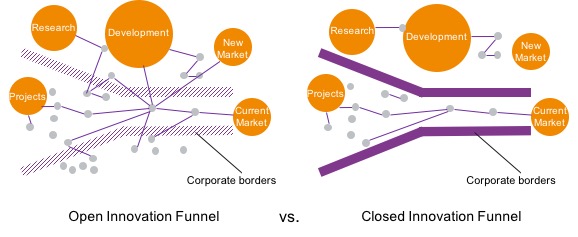
corporate innovation: how to make in-house start-ups successful
by Florian kraemer
For a few years now, we have seen the development of Digital and Innovation units, often called Labs, within large international corporations such as Samsung, BMW, Lufthansa, Unilever and many others in different industries. These established companies, with organically grown conservative working environments and corresponding hierarchical structures, try to master the digital transformation. Their aim is to stay competitive in fast-moving markets with unpredictable new business models and technologies. But reinventing themselves and developing new organizational structures that enable the creation of new and innovative products and services turn out to be one of the biggest challenges in the 21st century.
Their master solution: Establishing start-ups in-house to create new business models, disrupt existing approaches and access new business fields within a short space of time.
However, launching a unicorn under the umbrella of a process-linked corporation isn’t just about adding salt to soup. It’s way more: You need a whole recipe with the right ingredients.
The central question is: What impacts the success of in-house start-ups?
Through my empirical study in 2017, which included interviews with venture capitalists, innovation lab heads of outstanding innovation units as well as start-up CEOs, I detected five fundamental success factors including crucial measures to enable start-ups to grow within corporations.
#1: Create an innovation environment
Foster CEO support: CEO support in alignment with the overall corporate strategy is mandatory to build up an independent innovation unit. The unit’s activities need to be tightly aligned with the whole company’s strategic goals and business processes as well as get officially promoted by the CEO in professional networks, social media, the press and on the company’s website.
Build a corporate-wide future-oriented mindset: Companies need to identify their mindset across all hierarchy levels and define their position between a more conservative way of acting and a more visionary way of acting. With a more backward-facing mindset, companies tend to define markets to a specific industry. By contrast, the future-oriented mindset tends to focus on potential business models – taking higher risks, focusing on radical innovation and defining markets more broadly. For these reasons, it is necessary to appoint innovation leaders in the different divisions and departments to spread innovation right down to the rank and file.
#2: Set up an innovation lab
Set clear objectives for the innovation output: Specific qualitative and quantitative objectives enable the company to steer and measure innovation output more effectively.
Ensure high autonomy of teams: A high level of autonomy should be given to every project team on-site, as it typically knows the best way to engage and develop in order to achieve their goals.
Focus on specific business areas: While many firms lose focus shortly after starting their innovation unit, successful firms concentrate on certain business activities to broaden their product portfolio. This brings structure and defines fields for concentrating on innovation output.
Ensure decentralized innovation units: Decentralized units help to be more effective in organizing their own HR and IT support teams. Furthermore, it fosters more independence from C-level and allows higher autonomy in decision-making, which typically increases the innovation output.
Hire the right people: One of the most important factor in shaping the innovation activity profoundly is the employees. Framing the right team and keeping them motivated is crucial for the overall innovation output. My analysis made it impressively clear that corporations with a diverse workforce have a more creative output. Attributes for smart creative employees include playfulness, flexibility, and openness combined with a high level of energy and a risk-taking attitude. Moreover, corporate leaders need to be more tolerant toward those who are in some way “different” but have extraordinary talents to contribute.
Manage your stakeholders: Smart innovators understand that successful innovation can only be achieved if they manage and care about potential stakeholders within their corporation. A new technology or business model will never succeed if it does not convince decision-makers. Despite the fact that these innovators are in a secure cocoon of the innovation lab, they always have to strengthen their relationships with potential supporters and get things to scale.
#3: Launch a start-up development program
Provide collaboration: By launching a start-up development program, you provide start-ups with a platform for collaboration. This increases your chance to be the first to benefit from their developments. The attractiveness of your company gets a boost by the quality and quantity of what you offer.
Work on an attractive image: Achieve higher attractiveness by offering start-ups access to your customer base, business angels and Silicon Valley contacts.
Offer outstanding support: By providing office space, technical infrastructure, mentorship, strong support and the possibility to work on leading-edge technologies, you offer start-ups what they need in the conception phase. A recognized criterion for start-ups is also the record of accomplishment of a corporation.
#4: Design a clear innovation process
In order to ensure a full innovation funnel, I would advise creating an overall innovation process. By doing so, you can integrate external innovators in the development of new products and services. At best, the potential customer is asked directly for feedback at as many stages of the development process as possible.
Open vs. closed innovation funnel
The collaboration with external parties should be enforced in every phase of the innovation process. For the definition of search fields, during the generation of ideas, for development, testing, and the market launch, it is helpful to survey independent market participants and involve pilot customers.
#5: Implement a start-up integration process
Get innovation back: Most companies haven’t defined a clear framework for taking products or business models from the innovation lab back into the parent company or spinning them off as a standalone division or subsidiary.The leadership team is therefore often unprepared for managing the challenge of success when the start-up grows and customers demand for the product or service. For a project leader of a start-up under the umbrella of a corporation, the following structure should provide orientation in this stressful process:
Important factors for successful integration of start-ups into corporate structures
1. Develop an action plan
To administrate, organize and harmonize the next steps in the leave of the lab, prepare an action plan that everybody can review and which will be discussed in weekly jour fixes.
To structure the action plan, keep the following topics in mind: Organizational structure, HR, internal communication, legal aspects, budget, IT, product portfolio, branding, website.
2. Plan the organizational structure
There are three best practices to let your start-up flourish under the umbrella of a corporation:
• The integration into a related business unit
• The creation of a completely new division
• The spin-off as a subsidiary
3. Establish a transformation manager
This highly interconnected and senior professional acts as an intermediary and link between the line management and Innovation Lab, thus coordinating the strategic orientation of the start-up. The manager also points out which activities or processes can be harmonized and where synergies could arise.
4. Harmonize processes
In the event of integration of the start-up into a business unit, the likelihood of decreasing performance due to the forced adaption of corporate processes is relatively high. Therefore, the start-up should retain its processes and try to harmonize them successively with corporate ones.
5. Foster permanent communication
The integration of the start-up into a related business unit or spin-off as a subsidiary creates great uncertainty within the start-up team. This can quickly result in employees handing in their notice or employee dissatisfaction.
This is also reflected in a sharp drop in performance within the team. Therefore, one of the success factors in the transfer of the start-up is permanent communication and information in order to give the employees a feeling of security and certainty during the integration or spin-off phase.
6. Foster a failure culture
Outstanding results are easier to achieve in an environment where mistakes are accepted in favor of courage, independence and proactivity or speed. Start-ups often encourage this culture. The corporate culture instead tends to be more risk averse and employees usually protect themselves with excessive perfectionism, which prevents further innovation.
In summary, it is necessary to create a successful innovation environment for start-ups to let them grow within a corporation. By considering all the above-mentioned factors, corporations should be prepared to innovate and disrupt themselves. In order to make innovations possible, employees need the courage and power to embrace change and make a difference within the organization.
This article is also pulished on LinkedIn.











